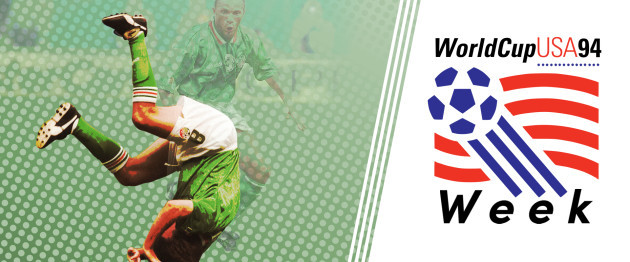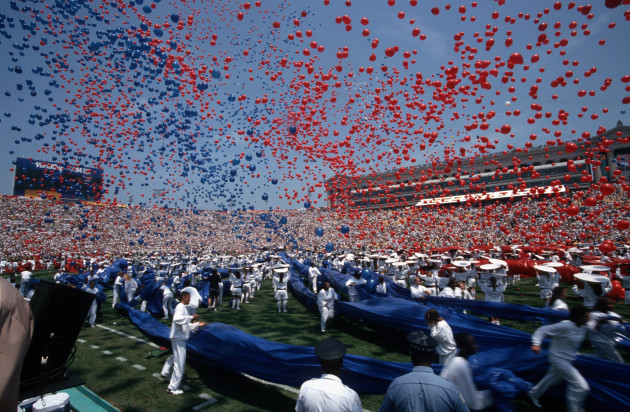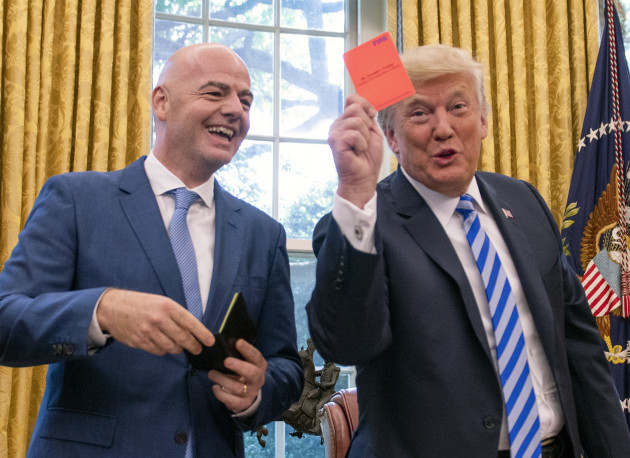This article is a part of The42′s USA 94 Week, a special series of commemorative features to celebrate the 25th anniversary of the 1994 Fifa World Cup. To read more from the series, click here >
SEAMUS MALIN GREW up as one of those fortunate Dubliners capable of looking out at the rest of the world, as existed beyond the arid, policed tastes of Eamon de Valera’s Insular Republic.
Decades later, he found himself holding a microphone as the lead summariser for ABC and ESPN, perched above the opening game of the 1994 World Cup as America finally swivelled its head to look out at the rest of the world’s great obsession.
“I’m looking at Soldier Field”, Malin recalls, “where the Chicago Bears are normally pounding people into the ground. Every seat is full, and this legendary theatre for American football is now for world football.
It almost brought me to tears, that all these years we have been working on this game in this country; 36 years after I first came, year after year after year of striving to get the game a fair hearing, and constantly being the butt of jokes – that it’s a ‘softies game’ all this nonsense – now, here is the biggest sporting event on planet Earth…and it’s in America.
Malin was born on the northside of Dublin, before his father “betrayed” the family and uprooted them to Mount Merrion on the other side of the Liffey. His family are originally from Meath, and Malin’s cousin’s son is one Liam Hayes.
Seamus’ father Brendan worked as a political reporter with the Irish Press, and was a mover in the legendary, stout-soaked Dublin journalism world of the 1940s and ’50s.
Brendan drank in the Palace Bar on Fleet Street with Patrick Kavanagh and Flann O’Brien, and Seamus can recall sitting with his brother on the stairs’ landing late at night, listening to Brendan Behan’s cavernous voice bounce through the house.
In spite of the country’s narrow tramlines – Seamus was taught by the rector at Belvedere College who told a biographer of then-banned, scandalous and disreputable alumnus James Joyce, “Ah, Joyce, not one of our successes” – his father instilled in him an appreciation of the wider world.
Brendan frequently travelled to the Council of Europe in Strasbourg to represent Irish journalists, and then landed a six-month exchange programme in Boston to cover Dwight Eisenhower’s presidential campaign, writing for The Boston Globe of his experience on ‘whistlestop tour’ train from city to city.
Here he mingled with notable political figures, meeting Richard Nixon and playing cards with Harry Truman. Brendan did return to Ireland, but the lure of a return to the U.S. proved too much, and with the economy spiralling downward in 1958, he took a permanent job offer from The Globe and moved the family across the Atlantic.
At this point, Seamus had just finished his Leaving Cert and had been expecting to start in UCD, given Trinity was pretty much off-limits as these were the last days of the Catholic requirement of the bishop’s written dispensation to attend.
In his teens, Seamus fell in love with soccer in spite of Belvedere’s best efforts.
“They didn’t let us play football there, in those days. It was considered a ruffian’s game, as opposed to rugby which was a gentleman’s game played by ruffians.”
He founded a soccer club in Mount Merrion, which still exists today. It wasn’t long before his love of the sport blurred with broadcasting, and he began doing sports reports for a Saturday evening show called Junior Sports Magazine on Raidió Éireann.
“I did a sufficiently good job that for the fourth or fifth job, they gave me a reel-to-reel tape machine which weighed about 25 pounds and was on a strap around my neck.
“The idea was that I’d go to a match and interview somebody, so they could roll it into the report.
The match started late of course, and I was looking at my watch thinking, ‘How am I going to get on my bike and get this back on time?’ They wouldn’t talk to me at half-time, so in the second half when the ball was down at the other goal I yelled at the left full-back to come over. I knew his name, and I started asking him questions. He was a real north Dubliner. ‘Paddy, how are you doing?’ and he said, ‘Ah, the lads are bleedin’ wonderful. We should be up by foive.’
“Then he looked around and said, ‘The ball’s coming, gotta go!’
“It was embarrassing, amateur theatrics.”
In the States, Seamus squeezed into a French and English Literature degree at Harvard, where he would stay on and work as an administrator for 40 years.
He also played and coached Ivy League soccer, and this provided a gateway into broadcasting. When working as the university’s assistant coach, Boston’s PBS station Channel 2 set-up next door, and approached the team to ask if there was anyone around who could commentate on the soccer games slated for broadcast.
“The coach and my good friend Bruce Monroe turned to me and said ‘This guy is from Dublin and he can talk you under the table, give him a try.”
Malin earned his break, and was soon hired by the New York Cosmos as their in-house commentator. There he spent some time flying around the country with Pele and Franz Beckenbauer, before joining ESPN in 1979, where he would go on to spend 30 years as their lead in-game analyst. Co-commentator, in our language.
Their early games were pretty harmless – mostly amateur, university games – but soon Malin found himself wielding words to match great moments, including European Cup games and international matches.
He flew to Italy in 1990 as it was the USA’s first World Cup in 40 years and Ireland’s first ever, and four years later, it came to him.
So, on 17 June 1994, millions of people tuned in to watch Germany play Bolivia to the soundtrack of Malin’s easy Dublin lilt.
Dreary question – was it soccer or football?
“Oh soccer. In this country, you have to.”
(Malin enjoys chiding the British people who claim ‘soccer’ is an American invention by referencing a sign reading ‘These gates to be opened only during soccer matches’ at the old Wembley.)
“Television in those days, for commentators, was a real challenge. If you spoke to the cognoscenti, you would be going over the heads of the curiosity watchers.
“The key was to balance both audiences; to keep the aficionados happy.
“You have to gently explain things that are obscure to people, I said to people that I won’t use the World Cup to explain the offside law. The producers said that I had to, that we’d lose the audience if not.
“So I said, ‘let’s wait until there is an offside decision, and when there’s a replay you can describe it in a way that both the viewer who knows the game can see straight away, while to the one who doesn’t you can explain why he’s offside.
“It was a delicate balance of keeping new viewers in mind while not insulting the people who knew the game. And I opted for the latter, when push came to shove.”
Amid heightened public interest in the World Cup, magazines and television stations across America found in Malin’s back-story – a Harvard administrator from Ireland who has become the voice of this huge, era-defining event - a way of covering it.
Not that this was necessarily a good thing for Malin.
“I lost my voice before the last-16 game between the US and Brazil. I just did interview after interview, and it was too much. So I got some probably terribly illegal steroid shot – I don’t want to know about it! – but whatever it was, it cured me within 12 hours and I got my voice back.”
Schedules meant he didn’t see too much of Ireland up close, and instead largely saw them from afar…spending a decent chunk of that time on the floor.
He spent 80 minutes “on the floor, praying” for the final whistle after Ray Houghton’s goal against Italy, and as for the last-16 game with the Dutch…
“I wasn’t doing that game, I was sitting in one of the TV trucks at another stadium. The guys in the TV trucks are an unusual breed; they are just professionals and they don’t know anything about the game, really.
I was watching the game, and because the fans had to find tickets and hotels for five days, they maxed out all of their credit cards. The camera for American television did one of these crowd pans, and they came on a bunch of Irish guys who held up a sign that said, ‘Our wives think we are at Lough Derg.’
“I was on the floor in tears of laughter. Nobody around me had a clue why it was so funny.
“I did explain Lough Derg to the guys in the truck and they found it pretty damn amusing, but it loses a little bit of its impact when you have to explain the joke.”
The two sides tugging at Malin’s affections left the competition on the same day – Independence Day – but he found victories elsewhere.
“Let me tell you – the ’94 World Cup still holds the record for gross attendance at a World Cup in history. That was not with 32 teams, it was still with 24.
“We had a lot of naysayers in this country. For the media who knew nothing about soccer, the best way to deal with that was to trash it, make fun of it. And as the tournament went on, you could hear the opinions turning. You could see the wave was pushed back; that wave of criticism.
“They said that ‘this is a sport for waiters and taxi drivers, nobody else in America cares. Nobody will come’.
“I said, let me tell you, you have no idea how many millions of ethnic Americans have been dying for a World Cup to come.
“So everybody who left Ecuador, everybody who left Italy – they will spend whatever they have to spend to get five or six tickets for the families.
“This is the world’s game, and it has come to them. They will feel like they’ve died and gone to heaven.
“So all of that wonderful melange that is the United States turned up massively, plus a lot of wealthy suburban people. Those two populations filled the stadia.
“One of the things I took most satisfaction from was from a very good writer with The LA Times, called Bill Plaschke. He didn’t know soccer, he couldn’t tell you if the ball was blown or stuffed.
“But his writings were stunning. He came in as a fairly ignorant guy, but a fair-minded guy. He just said, ‘Not my game, but I’ll show up’.
“He wrote this wonderful set of articles about what it was like to be in the stadiums, just about what it was like to be in this mini-cosmos of the world, to see these passionate ‘hyphenated-Americans’.
“Colombian, Brazilian, Italian, Irish – whoever.
“It reminded you of who we are and who our country is.
“He wrote that ‘it makes you look differently at the woman who comes in to clean your bathroom.’”
Plaschke struck on one of the World Cup’s greatest qualities – by looking out at it, it also allows you a fresh angle from which to look back in.
Given the World Cup will return to the United States in 2026 – co-hosts for the tournament along with Mexico and Canada – can it, in Malin’s opinion, work as a corrective to the isolationism clumsily preached and tweeted by the current president?
“The hope is you are absolutely right. The better hope is we don’t have to wait seven years. I think we have lost our way a little bit over here.
“The World Cup will be co-hosted, so it has an interesting advantage in that we are pulling in two other countries from the get-go. We are going to cross their border and they will cross ours.
“But for someone who loves living here – this nightmare needs to end sooner.”
Malin retired in 2009, and we finish up by considering the legacy of USA ’94.
The game is beginning to thrive in the States, with their women’s team among the best in the world and their men’s team slowly taking steps in the right direction – the day we speak, the American u20s side beat France 3-2 at the World Cup.
Playing-wise, Malin says that their next big challenge is to sink the game into the inner cities; while soccer is an attractive proposition for wealthy kids in the suburbs, it has yet to offer the kind of escape route from urban poverty that basketball does.
That said, only basketball and American football are played by more people than soccer and it will soon move ahead of baseball in terms of television audience.
“I go to a local pub in Santa Fe, New Mexico, which is not a hotbed of soccer. But there are enough people, and we have turned a regular sports bar into a soccer bar, to the point where the owner, when she sees me coming, says to the waitress, ‘Don’t charge him.’”
How’s that for a legacy?




